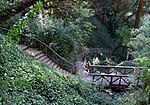Jewel Lake
AC with 0 elementsBerkeley HillsContra Costa County, California geography stubsFormer reservoirsLakes of the San Francisco Bay Area ... and 4 more
Reservoirs in CaliforniaReservoirs in Contra Costa County, CaliforniaReservoirs in Northern CaliforniaTilden Regional Park

Jewel Lake is a former reservoir and artificial lake along Wildcat Creek, a small stream in Northern California in Tilden Regional Park. It is located in the Wildcat Canyon between the Berkeley Hills and Sobrante Ridge Hills in an unincorporated area closest to Richmond and Kensington, California geographically and Berkeley accessibly. A wooden raised walkway built in the 1970s runs over marshland to the south of the lake. The dam and abandoned flood control machinery are visible at the north end of the lake.
Excerpt from the Wikipedia article Jewel Lake (License: CC BY-SA 3.0, Authors, Images).Jewel Lake
Lower Packrat Trail,
Geographical coordinates (GPS) Address Nearby Places Show on map
Geographical coordinates (GPS)
| Latitude | Longitude |
|---|---|
| N 37.912777777778 ° | E -122.26972222222 ° |
Address
Lower Packrat Trail
Lower Packrat Trail
94707
California, United States
Open on Google Maps






